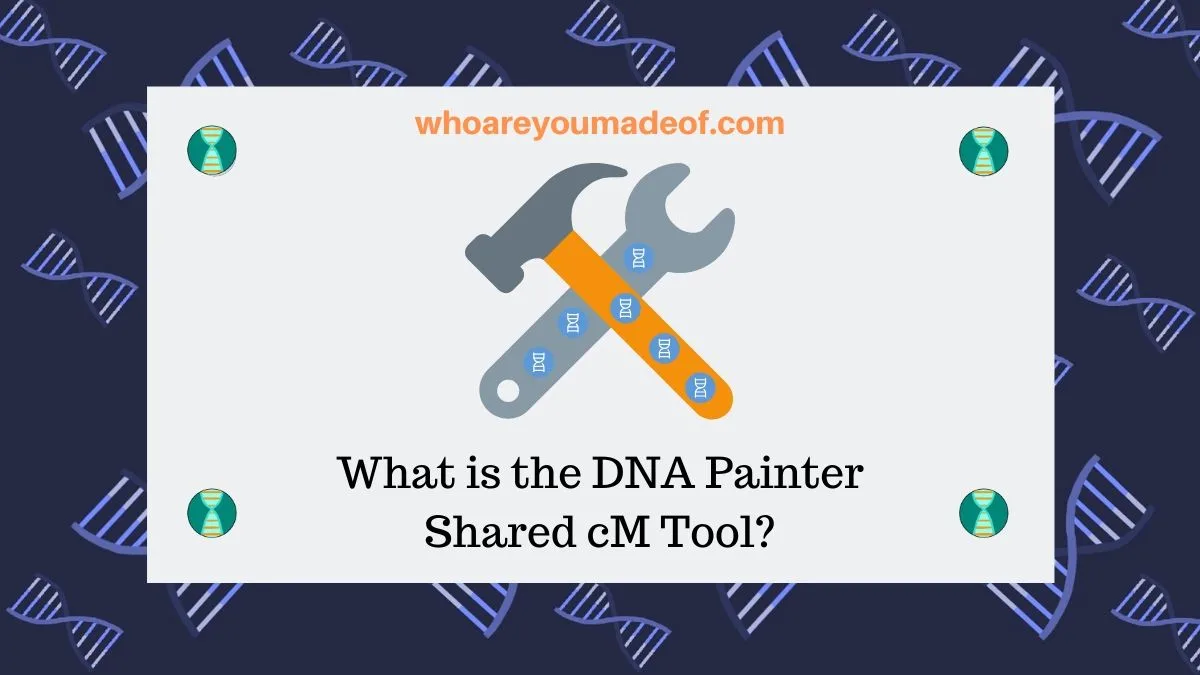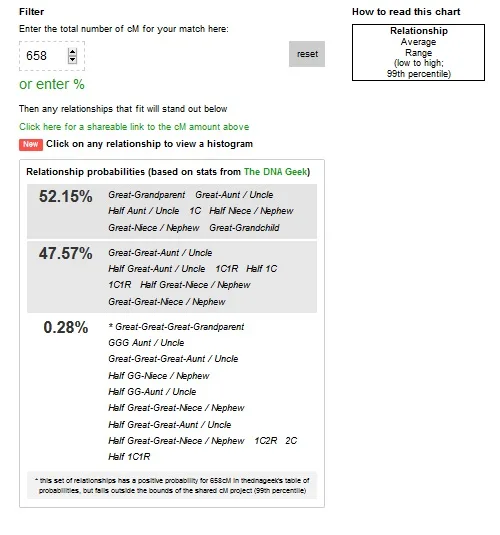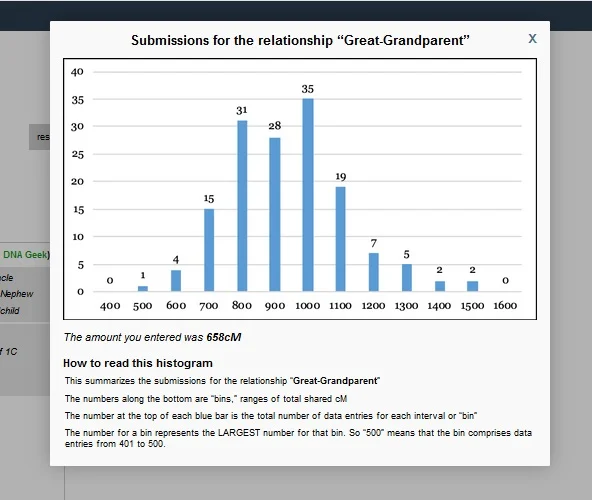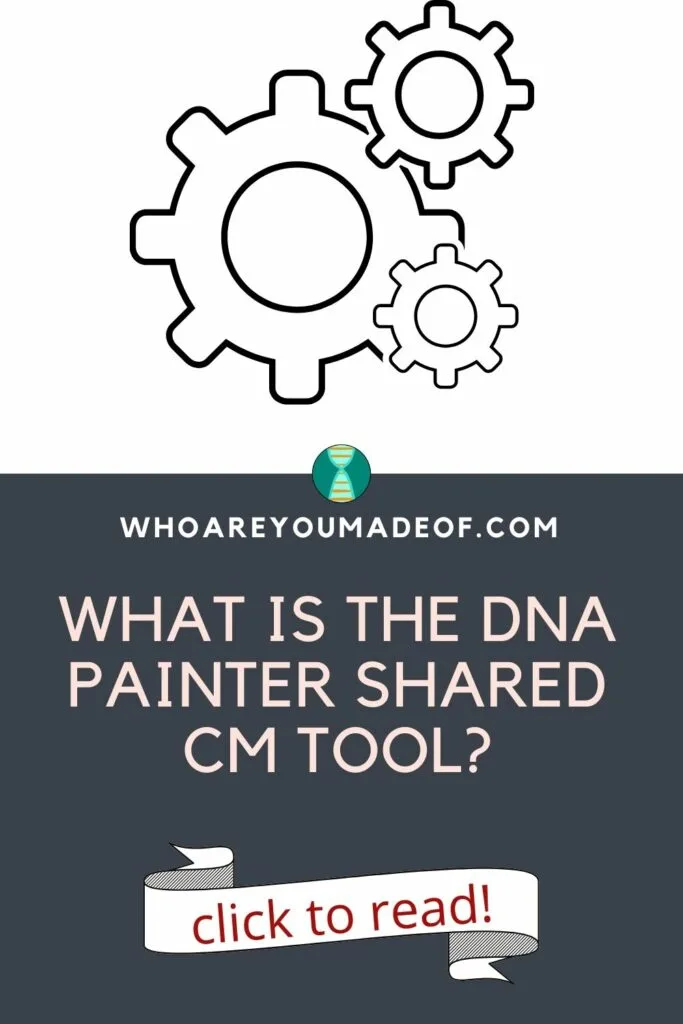Do you want to learn about the best cM DNA calculator? This calculator can tell us all of the relationships that we might have with our DNA match based on our total amount of shared DNA.
Why do we need a calculator like the Shared cM Tool?
The Shared cM Tool is helpful to those of us who would like to learn more about how we are connected to our DNA matches. In this post, find out what the DNA Painter Shared cM tool is, how it works, and where the data behind the tool comes from.

For any given relationship, there is a range of shared DNA typically seen between two relatives. If we know the amount of DNA that we share with our DNA relative, we can use the Shared cM tool to estimate how we might be related to our match.
Since most ranges of shared DNA overlap with others, the Shared cM Tool helps us work out which relationships are possible. In other words, we will likely find more than one possible relationship for any given percentage or number of shared centimorgans.
How does the Shared cM Tool work?
The Shared cM Tool, designed by Jonny Perl of DNA Painter, is very easy to use. To use the tool, simply enter in the amount of total shared DNA, measured in centimorgans or percentage, and the tool will highlight all of the relationship possibilities on the chart.
The Shared cM tool also provides us with probabilities corresponding to the possible relationships. This can help us determine how likely it is that our DNA match falls into any given relationship.
You can access the tool via this link:
For example, there might be several potential relationships listed. The potential relationships will be grouped together by their respective probabilities, and you will find that some of the relationships are more likely than others.
This is much easier than the way we used to use the chart. Before this tool, we would search the chart visually for ranges that could include the number of centimorgans that we are looking for. This often led us to overlook important possibilities.
How to understand the Shared cM Tool results
Understanding the Shared cM Tool results is easy to do! All we have to do is examine the probabilities next to the relationship list, and consider what we know about our family tree.
We may also want to take other DNA evidence into account. For example, the amount of DNA that my DNA match shares with my other relatives can help me narrow things down a bit.
For example, if I have a DNA match that shares 658 centimorgans with me, I see that there are more than two dozen possibilities as to how we might be related:

If I look at the probabilities, I can almost certainly safely eliminate all of the relationships that have only a .28% chance of being true for my DNA match. I would do this unless I have strong genealogical or other DNA evidence that one of those relationships applies.
Taking my own age and the age of the DNA match into account, I can likely eliminate several other possibilities. For example, since I am in my 40s, I am too young to have a great-great niece, and too old to have a living great-great aunt.
The Shared cM tool also offers a histogram. This allows us to see the distribution of shared centimorgans for any given relationship suggestion.
As an example, let's say that I think that my DNA match could be my great-grandparent. If I click on the great-grandparent link in the list of relationship possibilities, the histogram will pop up:

If you remember, I share 658 centimorgans with my hypothetical DNA match. I can see that 15 submissions fell into the 601-700 cM category.
Most of the submissions for this relationship category reported sharing more than 701 centimorgans with their great-grandparent.
Where does the data for the Shared cM Tool come from?
The data used to develop the Shared cM tool comes from a very ambitious project designed by Blaine Bettinger, a very knowledgeable and dedicated genetic genealogist.
Individual data points used to develop the expected ranges of DNA shared between relationship types were collected over the course of several years. The total number of individual submissions for the project currently numbers at more than 60,000.
In other words, individual people who have done DNA tests submitted the following information to the Shared cM Project:
- Known relationship
- Total Shared cM
- Longest Block (i.e. longest DNA segment)
- Number of shared DNA segments
- Whether there is known endogamy in this line of the family tree
- Name of testing company
Not every person will be able to fill out every detail in their submissions. For example, Ancestry DNA does not provide a chromosome browser or details about shared DNA segments, aside from the total number of shared segments.
Additionally, lots of people don't know whether they have endogamy in their family lines. When people are related in a few different ways, they might share more DNA than people usually do at that relationship distance.
This is a very valuable pool of information. The Shared cM Tool has made it possible to interact with this gigantic data set in a way that helps us understand how we might be related to our DNA matches.
For those of who you love ALL the gritty details, you can find Blaine's complete explanation of his project in a downloadable PDF.
Note: The project is still accepting submissions. You can submit your own submissions about how much you share with your known DNA matches HERE.
Is the Shared cM Tool always accurate?
Since the data that the tool uses to estimate a relationship was collected from individual submissions, there is always a possibility of error. This is most likely to occur when the amount of shared DNA seems to be on the extreme low or high side of the range for the relationship.

Conclusion
I hope that this post has helped you learn more about the Shared cM Tool and how you can use it to help you figure out how you are connected to your DNA matches.
If you have any questions about anything that you read in this post, please feel free to ask them in the discussion below.
Thanks for stopping by!

